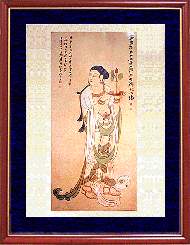
 |
|
18"x24" |
Chang
Dai-Chien (1899-1983)
Original: Hanging-scroll, Ink and colours on paper, 132 cm X 63.9 cm
 |
 |
 |
 |
Chang
Yuan (given name Chuan, but later changed to Yuan), was a native of
Nei-chiang, Szechwan province. His style name was Chi-yuan and he was also
known by the sobriquet Dai-chien. He was born in 1899 and died in 1983 at
the age of 85. Chang's mother began instructing him in painting at the age
of 9, and by 12 he could already paint landscapes. Figures and flowers and
enjoyed the fame of a child prodigy. At 16 he began formal study at the
middle school level and at 19 he went with his second brother, Chang Tse,
to Kyoto to study art. He returned to Shanghai at 21. Chang studied under
Tseng Nung-jan and Li Jui-ch'ing; he made rapid progress in both learning
and artistic capabilities.
In
1928 Chang served on the committee for the First National Art Exhibition,
and in 1931 he again traveled to Japan to serve as a delegate for the
exhibition of the Painting of the T'ang, Sung, Yuan, and Ming Dynasties.
In 1936 he was appointed professor at National Central University. And in
the summer of 1937, while Chang was vacationing in Peking, the Second
Sino-Japanese War broke out and the Japanese army occupied the capital.
Chang felt deep regret for being unable to rise up against the attacking
forces, but thought that he could contribute to his country by studying
the Tunhuang caves, which in modern times had astonished the world. China
itself had no scholars investigating Tunhuang, and Chang believed such
field work could constitute a way for a painter to serve his country.
Chang thus led a number of his students, sons and nephews to Tunhuang for
an initial three month expedition. But due to the difficulty of surveying
the entire site in such a short period of time, Chang took a second trip
and eventually spent a total of three years at the site. During this
period, Chang meticulously examined over 309 large and small caves, and
investigated the dates and styles of murals painted in the caves.
Furthermore, with the help of his students, sons and nephews, Tibetan
monks, and painting artisans, Chang vowed to make copies of over 200 of
the murals at Tunhuang. His research developed into a book entitled.
Records of the Mo-Kao Caves, His copies of murals were later exhibited in
China and abroad, spreading fame of the majestically beautiful paintings
at Tunhuang.
Chang
moved his family to Hong Kong in 1949 when the Communists occupied
mainland China. In the following year Chang and his family moved
to
Darjeeling, India. He studied the Buddhist murals at Ajanta and compared
differences between the murals of Tunhuang and India. In 1953 he moved his
family to South America, bought a farm in the outer region of Sao Paulo,
Brazil and began constructing the land into a Chinese-style garden, which
he named the Pa-te Garden. In 1956 Chang traveled to Rome and Paris, and
met the Western painting master Picasso in a villa in Nice; together they
discussed their mutual delectations. In 1970 the Brazilian government
repossessed the land of Chang's Pa-te Garden, and Chang subsequently moved
to a residence he named Huan-pi An on the west coast of the United States.
But as Chang became older, he became increasingly nostalgic of his past
and his country, and he decided to move to Taiwan. In 1976 he began
construction of his new residence, the Mo-ye Ching-she, in Waishuanghsi,
Taipei. By 1978 construction was complete and he moved in. In 1982, he was
personally presented with the Chiang Kai-shek Medal by President Chiang
Ching-kuo in honor of Chang’s outstanding achievements and contributions
to the artistic realm.
Chang Dai-chien's calligraphy was influenced by Tseng Nung-jan and Li Jui-ch'ing. In his early years, he copied inscriptions of the Hsia, Shang(16th-11th c. B.C.), Chou (11th-3rd c. B.C.) and Han (221 B.C.-A.D. 220) dynasties, and later he examined rubbings from steles of the Six Dynasties Period(220-589) and the T'ang (618-907) dynasty. His study of calligraphy also included an examination of t'iehs. Chang began learning painting by studying the styles of the four monks of the late Ming dynasty (1368-1644) and was particularly adept at capturing the style of Shih T'ao (1642-1707). Chang further studied various artists of the T'ang, Sung (960-1279) and Yuan (1271-1368) dynasties. People have praised him as being the finest artist of the past 500 years, as he was able to grasp thoroughly the essence of past masters, but did not allow their achievements to limit his own capabilities. In his late years, Chang surpassed the techniques of the ancients and created a new method known as splashed-ink-and-color painting. In exceeding the brush and ink methods of the ancients, Chang's achievements created a new world in which his art surpassed the confines of images, was not restrained by rules or methods, and was full of variation.